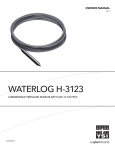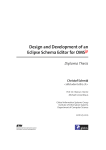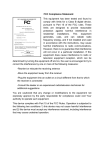Download USER`S MANUAL
Transcript
GA-7A8DRL AMD Socket 940 Dual Processor Motherboard USER’S MANUAL AMD Opteron™ Socket 940 Dual Processor Motherboard Rev. 1001 12ME-7A8DRL-1001 GA-7A8DRL Motherboard Table of Content Item Checklist ......................................................................................... 4 WARNING! ............................................................................................... 4 Chapter 1 Introduction ............................................................................. 5 Summary of Features .................................................................................. 5 GA-7A8DRL Motherboard Layout ............................................................... 7 GA-7A8DRL Motherboard Layout (With ZCR) ............................................ 8 Chapter 2 Hardware Installation Process .............................................. 10 Step 1: Installing Processor and CPU Cooling Fan.................................. 11 Step1-1: Installing CPU .................................................................................................... 11 Step1-2: Installing Cooling Fan ........................................................................................ 13 Step 2: Install memory modules ................................................................ 15 Step 3: Install expansion cards ................................................................. 18 Step 4: Connect ribbon cables, cabinet wires, and power supply ........... 19 Step4-1:I/O Back Panel Introduction ................................................................................ 19 Step4-2: Connectors Introduction ..................................................................................... 21 Step4-3: Jumper Setting Introduction ................................................................................ 32 Chapter 3 BIOS Setup .......................................................................... 36 Main ........................................................................................................... 38 Advanced ................................................................................................... 42 Chipset Configuration ....................................................................................................... 45 I/O Device Configuration ................................................................................................. 46 PCI Configuration ............................................................................................................ 47 Hardware Monitor ........................................................................................................... 48 Console Redirection ........................................................................................................ 50 Security ...................................................................................................... 52 Boot ............................................................................................................ 54 Exit ............................................................................................................. 55 2 Table of Content Chapter 4 Technical Reference ............................................................ 57 Block Diagram ........................................................................................... 57 Chapter 5 Application Driver Installation ............................................... 58 A.Intel Network Driver Installation .................................................................................... 58 B.Adaptec 8130 HostRaid Driver Installation .................................................................... 59 C.Adaptec Storage Manager Software Installation ............................................................ 60 D.DirectX 9.0 Driver Installation ....................................................................................... 62 Chapter 6 Appendix .............................................................................. 63 3 GA-7A8DRL Motherboard Item Checklist ; The GA-7A8DRL motherboard ; PATA Cable x 2 ; ; GC-MADS4 Card FDD Cable x 1 ; CD for motherboard driver & utility ; GA-7A8DRL user’s manual ; ; I/O shield x 1 SCSI cable x 1 ; Quick Reference Guide x 1 WARNING! Computer motherboards and expansion cards contain very delicate Integrated Circuit (IC) chips. To protect them against damage from static electricity, you should follow some precautions whenever you work on your computer. 1. Unplug your computer when working on the inside. 2. Use a grounded wrist strap before handling computer components. If you do not have one, touch both of your hands to a safely grounded object or to a metal object, such as 3. the power supply case. Hold components by the edges and try not touch the IC chips, leads or connectors, or 4. other components. Place components on a grounded antistatic pad or on the bag that came with the 5. components whenever the components are separated from the system. Ensure that the ATX power supply is switched off before you plug in or remove the ATX power connector on the motherboard. Installing the motherboard to the chassis… If the motherboard has mounting holes, but they don’t line up with the holes on the base and there are no slots to attach the spacers, do not become alarmed you can still attach the spacers to the mounting holes. Just cut the bottom portion of the spacers (the spacer may be a little hard to cut off, so be careful of your hands). In this way you can still attach the motherboard to the base without worrying about short circuits. Sometimes you may need to use the plastic springs to isolate the screw from the motherboard PCB surface, because the circuit wire may be near by the hole. Be careful, don’t let the screw contact any printed circuit write or parts on the PCB that are near the fixing hole, otherwise it may damage the board or cause board malfunctioning. 4 Introduction Chapter 1 Introduction Summary of Features Form Factor 30.4cm x 26.9cm ATX size form factor, 6 layers PCB. Motherboard CPU GA-7A8DRL Motherboard Support Dual Opteron processors (Sledge Hammer) The HyperTransport link of the AMD Opteron processor is capable of operating at 400, 800, 1200, and 1600 MT/s. Chipset AMD-8131 North Bridge HyperTransport PCI-X chipset provides two independent, high-performance PCI-X bus bridges, interated with a high-speed HyperTransport technology tunnel. AMD-8111 HyperTransport I/O Hub replaces the traditional southbridge. This component integrates storage, connectivity, audio, I/O expansion and system management functions into a single Memory device. Supports 4 * DDR socket slots for Primary CPU Supports 4 * DDR socket slots for Secondary CPU CPU1 supports memory capacity up to 8GB CPU2 supports memory capacity up to 16GB I/O Control Supports registered ECC and DDR200/266/333/400 ITE IT8712F Super I/O SATA RAID (via SO-DIMM Adaptec AIC-8130 controller Supports RAID 0,1 daughter card) Expansion Slots Supports 4 SATA Connectors Supports 2 x PCI 32Bit/ 33Mhz Slots Supports 2 x PCI-X 64Bit/100MHz Slots Supports 2 x PCI-X 64Bit/66MHz Slots On-Board Peripherals Supports 1 x PCI-X 64Bit/66MHz Slot by SO-DIMM(SCSI card) 1 Floppy port supports 2 FDD with 360K, 720K,1.2M, 1.44M and 2.88M bytes. 1 Parallel port supports Normal/EPP/ECP mode 1 Serial ports (COMA) 1 VGA connector 2 USB ports (USB1.1) 5 GA-7A8DRL Motherboard Hardware Monitor Winbond W83791D CPU/System Fan Revolution detect CPU/System temperature detect System Voltage Detect Power Managerment Features Power Management Support Wake-on-LAN (WOL), USB, PCI, mouse On-Board VGA Supports ACPI S1/S4/S5 functions Build in ATI Rage XL with 8M SDRAM on board On-Board LAN Intel 82545GM Intel 82541GI PS/2 Connector BIOS PS/2 Keyboard interface and PS/2 Mouse interface Phoenix BIOS on 4Mb flash RAM Additional Features SMBus Support IOAPIC Support Serial IRQ Support AC Recovery 0 Please set the CPU host frequency in accordance with your processor’s specifications. We don’t recommend you to set the system bus frequency over the CPU’s specification because these specific bus frequencies are not the standard specifications for CPU, chipset and most of the peripherals. Whether your system can run under these specific bus frequencies properly will depend on your hardware configurations, including CPU, Chipsets,SDRAM,Cards….etc. 6 Introduction GA-7A8DRL Motherboard Layout I W 1 H 18 G V O U T 5 7 11 Y B 17 Z J P M 9 L S D 6 8 15 16 K 4 E N 14 3 F X 12 13 2 C A R Q GA-7A8DRL 10 7 GA-7A8DRL Motherboard GA-7A8DRL Motherboard Layout (With ZCR) 20 19 7 1 21 7 22 1 7 23 1 7 24 1 GA-7A8DRL 0 8 Introduction A. B. C. D. E. F. G. H. CPU1 CPU2 AMD8131 AMD8111 Intel 845GM Intel 82541GI BIOS EM638325TS-6 1. 2. 3. 4. 5. 6. 7. 8. GLAN2 GLAN1 VGA1 LPT1 COMA1 USB3 KB_MS (Keyboard/Mouse) ATX2 (SSI power connector) I. J. K. L. M. N. O. P. Q. R. PWR_FAN2 (Power Fan) PWR_FAN1 (Power Fan) ITE8712 CPU_FAN1 (CPU Fan) CPU_FAN2 (CPU Fan) SYS_FAN1 (System Fan) WOL WOM Front Panel1 USB1 (Front USB) 9. 10. 11. 12. 13. 14. 15. 16. 17. 18. ATX1 (SSI power connector) CPU1 DIMM 0~3 CPU2 DIMM 0~3 PCI_6 PCI_5 PCI-X_4 PCI-X_3 PCI-X_2 PCI-X_1 ATI_Rage XL S. IDE2 19. Adaptec AIC-8130 T. U. V. W. X. Y. Z. IDE1 GSMI (IPMI) FDD1 (Floppy Connector) COMB IPMB1 IPMB2 BAT1 (Battery) 20 21. 22. 23. 24. ZCR_CON (ZCR Connector) SATA0 SATA1 SATA2 SATA3 9 GA-7A8DRL Motherboard Chapter 2 Hardware Installation Process To set up your computer, you must complete the following steps: Step 1- Install the Central Processing Unit (CPU) Step 2- Install memory modules Step 3- Install expansion cards Step 4- Connect ribbon cables, cabinet wires, and power supply Step 5- Setup BIOS software Step 6- Install supporting software tools Step 2 Step 3 Step 5 Step 4 Step 4 Step 1 Step 4 Step 4 Step 1 10 Step 2 Hardware Installation Process Step 1: Installing Processor and CPU Cooling Fan Before installing the processor and cooling fan, adhere to the following cautions: 1. The processor will overheat without the heatsink and/or fan, resulting in permanent irreparable damage. 2. Never force the processor into the socket. 3. Apply thermal grease on the processor before placing cooling fan. 4. Please make sure the CPU type is supported by the motherboard. 5. If you do not match the CPU socket Pin 1 and CPU cut edge well, it will cause improper installation. Please change the insert orientation. Please use AMD approved cooling fan. Step1-1: Installing CPU Step 1. Rise the lever bar on the socket. Step 2. Aligning the pins of the processor with the socket, insert the processor into the socket. Step 3 Close the lever completely. Angling the Figure 1.Angling the rod to 65-degree maybe feel a kind of tight , and then continue pull the rod to 90rod to 650 degree when a noise “cough” made. Socket Actuation Lever Figure 2.Pull the rod to the 90-degree directly. 11 GA-7A8DRL Motherboard Figure 3. A1 pin location on the Socket and Processor.Move the socket lever to the locked position while holding pressure on the center of the processor. Step 4. When the processor installation is completed, apply thermal grease to the processor(as shown in Figure 4) prior to installing the heatsink. AMD recommends using a high thermal conductivity grease for the thermal interface material rather than a phase change material. Phase change materials develop strong adhesive forces between the heatsink and processor. Removing the heatsink under such conditions can cause the processor to be removed from the socket without moving the socket lever to the unlocked position and then damage the processor pins or socket contacts. ** We recommend you to apply the thermal tape to provide better heat conduction between your CPU and heatsink. (The CPU cooling fan might stick to the CPU due to the hardening of the thermal paste. During this condition if you try to remove the cooling fan, you might pull the processor out of the CPU socket alone with the cooling fan, and might damage the processor. To avoid this from happening, we suggest you to either use thermal tape instead of thermal paste, or remove the cooling fan with extreme caution.) iFigure 4. Application of Thermal Grease to the processor. 12 Hardware Installation Process Step1-2: Installing Cooling Fan Step 1. Attach th cooling fan clip to the processor scoket. Align the heatsink assembly with the support frame mating with the backer plate standoffs as shown in Figure 5&6. Step 2. Coonect the processor fan cable to the processor fan connector. Note: ** We recommend you to buy the kind of cooling fan which is shown in Figure 8. This type of cooling fan will provide the best performance for heat releasing. Figure 5&6 Alignment of Heatsink Assembly with Standoffs 1 2 3 4 5 6 7 8 9 10 11 12 Y G Y 14 13 G A B C D E F G H 9 1 1 9 2 2 J K L M N P 10 Y W 10 V U T R P N M L K J H G FE D C B A 1 2 3 4 5 6 7 8 9 10 11 12 13 14 15 16 17 18 19 20 1 2 AL AK AJ AH AG AF AE AD AC AB AA Y W V U T R P N M L K J H G F E D C B A 31 30 29 28 27 26 25 24 23 22 21 20 19 18 17 16 15 14 13 12 11 1 10 9 8 7 6 5 4 3 2 1 70 69 26 E D C B A P N M L K J H G F T R AJ AH AG AF AE AD AC AB AA Y W V U 25 24 23 22 21 20 19 18 17 16 15 14 13 12 11 10 9 8 7 6 5 4 3 2 1 2 3 4 5 6 7 8 9 10 11 12 13 14 15 16 17 18 22 23 26 27 28 29 1 2 3 4 5 6 7 8 9 10 11 12 13 14 15 16 17 18 19 20 21 22 23 24 25 26 27 28 29 30 31 A B C D E F G H J K L M N P R T 2 3 4 5 AD 7 6 AE AF 9 8 AG AH AK AL Figure 7 Connecting CPU FAN connector 16 15 14 13 11 10 12 AJ 17 D B A 1 Y AC 18 C W AB 19 E F V AA 20 K H T P M Y G R J L U V U N A N P R H J K L M T U V W Y AA AB AC AD AE AF 19 20 21 24 25 W B C D E F G 1 13 GA-7A8DRL Motherboard Figure 8. Recommended cooling fan Figure 9. Air Flow direction 14 Hardware Installation Process Step 2: Install memory modules Before installing the processor and heatsink, adhere to the following warning: Please note that the DIMM module can only fit in one direction due to the one notches. Wrong orientation will cause improper installation. Please change the insert orientation. The motherboard has 8 dual inline memory module (DIMM) sockets. The BIOS will automatically detects memory type and size. To install the memory module, just push it vertically into the DIMM socket . Memory size can vary between sockets. CPU2 DIMM1 CPU2 DIMM3 CPU2 DIMM0 CPU DIMM0 CPU DIMM1 CPU DIMM2 CPU DIMM3 CPU2 DIMM1 Notch CPU1 DIMM3 CPU1 DIMM2 CPU1 DIMM0 CPU1 DIMM1 15 GA-7A8DRL Motherboard Total Memory Sizes With Registered DDR DIMM Devices used on DIMM 64 Mbit (4Mx4x4 banks) 64 Mbit (2Mx8x4 banks) 64 Mbit (1Mx16x4 banks) 128 Mbit(8Mx4x4 banks) 128 Mbit(4Mx8x4 banks) 128 Mbit(2Mx16x4 banks) 256 Mbit(16Mx4x4 banks) 256 Mbit(8Mx8x4 banks) 256 Mbit(4Mx16x4 banks) 1 DIMMx64/x72 256 MBytes 128 MBytes 64 MBytes 512 MBytes 256 MBytes 128 MBytes 1 GBytes 512 MBytes 256 MBytes 2 DIMMsx64/x72 512 MBytes 256 MBytes 128 MBytes 1 GBytes 512 MBytes 256 MBytes 2 GBytes 1 GBytes 512 MBytes 3 DIMMsx64/x72 768 MBytes 384 MBytes 192 MBytes 1.5 GBytes 768 MBytes 384 MBytes 3 GBytes 1.5 GBytes 768 MBytes 4 DIMMsx64/x72 1 GBytes 512 MBytes 256 MBytes 2 GBytes 1 GBytes 512 MBytes 4 GBytes 2 GBytes 1 GBytes 512 Mbit(32Mx4x4 banks) 2 GBytes 4 GBytes 4 GBytes 4 GBytes 512 Mbit(16Mx8x4 banks) 512 Mbit(8Mx16x4 banks) 1 GBytes 512 MBytes 2 GBytes 1 GBytes 3 GBytes 1.5 GBytes 4 GBytes 2 GBytes Installation Step: 1. Unlock a DIMM socket by pressing the retaining clips outwards. 2. Aling a DIMM on the socket such that the notch on the DIMM exactly match the notches in the socket. 3. Firmly insert the DIMMinto the socket until the retaining clips snap back in place. 4. The processor supports 64-bit mode and 128-bit mode configuration of the DIMMs. In 64 bit mode, only DIMM 0 and 2 can be populated. Possible combinations of DIMMs in 64 bit mode are listed in Table 1. In 128 bit mode, minimum of two DIMMs is required to create the 128 bit bus; therefore, DIMMs can only be populated in even numbered pairs in slot 0 & 1, and 2& 3. Each logical DIMM must be madeof two identical DIMMs having the same device size on each and the same DIMM size. Regardless of mode, DIMM must be populated in order starting at the farest slotfrom the processor. Table 2 & 3 shows the possible combination of DIMMs for 128 mode. Not all possbile combinations are listed in the tables. 5. Installed DIMMs must be the same speed and must all be registered. For a list of suuported memrory, please refer to the table list above. 6. Reverse the installation steps when you wish to remove the DIMM module. Locked Retaining Clip 16 Hardware Installation Process Table 1. Vaild DIMM Configuration for 64 bit Mode DIMM 0 (MB) X 256 X 512 X 1024 X 2048 X 4096 Note: X = Do not DIMM 2 (MB) 256 256 512 512 1024 1024 2048 2048 4096 4096 populate Table 2. Vaild DIMM Configuration for 128 bit Mode Logical DIMM 0 DIMM 0 (MB) X Ligical DIMM1 DIMM 1 (MB) X DIMM 2 (MB) 256 DIMM 3 (MB) 256 256 X 256 X 256 512 256 512 512 X 512 X 512 1024 512 1024 1024 X 1024 X 1024 2048 1024 2048 2048 X 2048 X 2048 4096 2048 4096 4096 4096 Note: X = Do Not populate 4096 4096 17 GA-7A8DRL Motherboard Step 3: Install expansion cards 1. Read the related expansion card’s instruction document before install the expansion card into the computer. 2. Remove your computer’s chassis cover, screws and slot bracket from the computer. 3. Press the expansion card firmly into expansion slot in motherboard. 4. Be sure the metal contacts on the card are indeed seated in the slot. 5. Replace the screw to secure the slot bracket of the expansion card. 6. Replace your computer’s chassis cover. 7. Power on the computer, if necessary, setup BIOS utility of expansion card from BIOS. 8. Install related driver from the operating system. 18 Hardware Installation Process Step 4: Connect ribbon cables, cabinet wires, and power supply Step4-1:I/O Back Panel Introduction 19 GA-7A8DRL Motherboard PS/2 Keyboard and PS/2 Mouse Connector To install a PS/2 port keyboard and mouse, plug the mouse to the upper port (green) and the keyboard to the lower port (purple). USB Port Before you connect your device(s) into USB connector(s), please make sure your device(s) such as USB keyboard, mouse, scanner, zip, speaker...etc. have a standard USB interface. Also make sure your OS supports USB controller. If your OS does not support USB controller, please contact OS vendor for possible patch or driver updated. For more information please contact your OS or device(s) vendors. / / Parallel Port / Serial Port / VGA Port This connector supports 1 standard COM port and 1 Parallel port. Device like printer can be connected to Parallel port ; mouse and modem etc can be connected to Serial port. / LAN Port The provided Internet connection is Gigabit Ethernet, providing data transfer speeds of 10/ 100/1000Mbps. LAN LED Description Name LAN Link/Activity 10/100 LAN Speed GbE LAN Speed Color Green Condition ON Description LAN Link / no Access Green - BLINK OFF LAN Access Idle Green - ON OFF 100Mbps connection 10Mbps connection Yellow Yellow ON BLINK 1Gbps connection Port identification with 1Gbps connection Green Green ON BLINK 100Mbps connection Port identification with 10 or 100Mbps connection - OFF 10Mbps connection 20 Connector Introduction Step4-2: Connectors Introduction R MK F S G P B I Q C L O J X A D T 7 1 7 E 1 7 1 H U V 7 W 1 0 N 21 GA-7A8DRL Motherboard A) B) C) D) E) F) G) H) AXT1 ATX2 IDE1 IDE2 USB1 SYS_FAN1 SMBUS1 F_Panel M) N) O) P) Q) R) S) T) I) J) K) L) FDD1 PWR_FAN1 PWR_FAN2 WOM1 U) SATA1 V) SATA2 W) SATA3 X) BAT (Battery) 22 WOL1 CPU_FAN1 CPU_FAN2 COMB GSMI1 IPMB1 IPMB2 SATA0 Connector Introduction A ) ATX1 13 1 7 1 7 1 7 Definition 1 2 +3.3V +3.3V 3 4 GND +5V 5 6 GND +5V 7 8 GND POK 9 10 5VSB +12V 11 12 +12V +3.3V 13 14 +3.3V -12V 15 16 GND PSON 17 18 GND GND 19 20 GND -5V 21 22 +5V +5V 23 24 +5V GND 1 PIN No. 7 1 0 24 ¾ AC power cord should only be connected to your power supply unit after ATX power cable and other related devices are firmly connected to the mainboard. 12 B ) ATX2 1 Pin No. 1 2 3 4 5 6 7 8 Definition GND +12v GND +12V GND +12V GND +12V 7 1 ¾This connector (ATX +12V) is used only for CPU Core Voltage. 7 1 7 1 7 1 0 23 GA-7A8DRL Motherboard C / D) IDE 1/2 Please connect first harddisk to IDE1 and connect CDROM to IDE2. The red stripe of the ribbon cable must be the same side with the Pin1. 2 39 40 7 1 1 7 1 7 1 7 1 0 E) USB1 1 2 9 10 PIN No. Definition 1 VCC 2 GND 3 -Data 0 4 Key 5 +Data 0 6 +Data 1 7 Key 8 -Data 1 9 GND 10 VCC 7 1 7 1 7 ¾ Be careful with the polarity of the front panel 1 7 USB connector. Check the pin assignment while you connect the front panel USB cable. 1 0 Please contact your nearest dealer for optional front panel USB cable. 24 Connector Introduction F ) SYS_FAN1 (System FAN) 1 Pin No. 1 2 3 Definition GND +12V Sense 7 1 7 1 7 1 7 1 0 G ) SMBUS1 (SMBus Connector) 1 7 1 7 1 7 1 7 1 0 25 Pin No. 1 2 3 4 Definition GND KEY Data Clock GA-7A8DRL Motherboard H) F_Panel1 (2X10 Pins) Please connect the power LED, PC speaker, reset switch and power switch etc of your chassis front panel to the front panel jumper according to the pin assignment below. IDE Hard Disk Active LED Reset Switch Power Sleep LED 1 2 HD+ HD RST RST+ NC MPD+ MPD PW+ PW SPK+ NC NC SPK - 19 20 Soft Power Connector Speaker 7 Connector 1 7 1 7 1 7 1 0 Pin No 1 2 3 4 5 6 7 8 9 10 11 12 13 14 15 16 17 18 19 20 Signal Name Description HD+ MPD+ HDMPDRSTPW+ RST+ PWNC KEY KEY KEY KEY SPK+ KEY NC KEY NC KEY Speaker- Hard Disk LED pull up (330 ohm) Pull up 330 ohm Hard Disk Active LED Signal Suspend LED (Blinking) Ground Front Panel Power On/Off Button Signal Ground Front Panel Power On/Off Button Signal(GND) No Connect KEY KEY KEY KEY Speaker connector (5V Standby) KEY No Connect KEY No Connect KEY Speaker connector 26 Connector Introduction I ) FDD1 (Floppy Connector) Please connect the floppy drive ribbon cables to FDD. It supports 360K,720K,1.2M,1.44M and 2.88Mbytes floppy disk types. The red stripe of the ribbon cable must be the same side with the Pin1. 34 33 7 1 7 1 7 1 7 1 2 1 0 J / K ) PWR_FAN1/2 (Power Fan Connectors) This connector allows you to link with the cooling fan on the system case to lower the system temperature. PWR_FAN2 1 PWR_FAN1 7 1 7 1 7 1 7 1 0 27 Pin No. 1 2 3 Definition GND +12V Sense GA-7A8DRL Motherboard L) WOM1 (Wake on Moderm Connector) Pin No. 1 2 1 Definition Ring GND 7 1 7 1 7 1 7 1 0 M) WOL1 (Wake On LAN Connector) This connector allows the remove servers to manage the system that installed this mainboard via your network adapter which also supports WOL. 1 Pin No. 1 2 3 7 1 7 1 7 1 7 1 0 28 Definition +5V SB GND Signal Connector Introduction N / O ) CPU_FAN 1/2 (CPU Fan Connectors) Please note, a proper installation of the CPU cooler is essential to prevent the CPU from running under abnormal condition or damaged by overheating.The CPU fan connector supports Max. current up to 600 mA. Pin No. 1 2 3 1 Definition GND +12V Sense 7 1 7 1 CPU_FAN2 7 1 7 1 0 CPU_FAN1 P ) COMB 1 7 1 7 1 7 1 7 1 0 29 Pin No. 1 2 3 4 5 6 7 8 9 10 Definition NDCDB NSINB NSOUTB NDTRB GND NDSRBNRTSBNCTSBNRIBNC GA-7A8DRL Motherboard Q ) GSMI1 This connector is for the IPMI function and must bundle with IPMI module. 7 1 7 1 7 1 7 1 0 R / S ) IPMB1/2 (IPMB Connectors) IPMB2 IPMB1 7 1 7 1 7 1 7 1 0 30 1 Pin No. 1 2 3 Definition Serial Clock GND Serial Data Connector Introduction T / U/ V / W ) SATA 0/1/2/3 (Serial ATA Connectors) You can connect the Serial ATA device to this connector, it provides you high speed transfer rates (150MB/sec). 7 1 7 SATA0 SATA1 Pin No. 1 2 3 4 5 6 7 Definition GND TXP TXN GND RXN RXP GND 1 7 1 7 1 7 1 0 SATA3 SATA2 X ) BAT (Battery) + CAUTION 7 Danger of explosion if battery is incorrectly replaced. 1 7 1 7 1 Replace only with the same or equivalent type recommended by the manufacturer. 7 1 0 If you want to erase CMOS... Dispose of used batteries according to the 1.Turn OFF the computer and unplug the power cord. manufacturer’s instructions. 2.Remove the battery, wait for 30 second. 3.Re-install the battery. 4.Plug the power cord and turn ON the computer. 31 GA-7A8DRL Motherboard Step4-3: Jumper Setting Introduction 1 2 5 4 3 1 ) JP1 2 ) JP2 3 ) JP4 PCI-X 1.2 82545GM PCI-X 3.4 SCSI 7902 4 ) JP7 5 ) CLR_CMOS1 (Clear CMOS) PCI-X 66MHz JP2 PIN2-3 short JP1 PIN2-3 short PCI-X 100MHz JP2 PIN1-2 short JP7 PIN1-2 short JP1 PIN1-2 short JP4 PIN1-2 short 32 PCI-X 133MHz JP2 PIN1-2 short JP7 PIN2-3 short JP1 PIN1-2 short JP4 PIN2-3 short Jumper Setting 1) JP1 (PCI-X Bus Speedy Function) 1 1-2 close: Enable PCI-X 3 & 4 and SCSI 100/133 Mhz (default) 1 2-3 close: Enable PCI-X 3 & 4 and SCSI 66Mhz 2) JP2 (PCI-X Bus Speedy Function) 1 1-2 close: Enable PCI-X 1 & 2 and 545GM 100/133 Mhz (default) 1 2-3 close: Enable PCI-X 1 & 2 and 545GM 66Mhz 33 GA-7A8DRL Motherboard 3) JP4 (PCI-X Bus Speedy Function) 1 1-2 close: Enable PCI-X 3 & 4 and SCSI at 100 Mhz (default) 1 2-3 close: Enable PCI-X 3 & 4 and SCSI at 133 Mhz 1 1-2 close: Enable PCI-X 1&2 and 545GM 100 Mhz (default) 1 2-3 close:Enable PCI-X 1 & 2 and 545GM 133 Mhz 4) JP7 (PCI-X Bus Speedy Function) 34 Jumper Setting 5) CLR_CMOS1 (Clear CMOS Function) You may clear the CMOS data to its default values by this jumper. Default value doesn’t include the “Shunter” to prevent from improper use this jumper. To clear CMOS, temporarily short 1-2 pin. 1 1-2 close: Clear CMOS 1 2-3 close: Normal (Default) ** Recommendation frequency setting and slot: Mode PCI-X PCI-X PCI-X PCI Frequency Maximum slots or devices (on board) 133 1 100 2 66 3 66 3 35 GA-7A8DRL Motherboard Chapter 3 BIOS Setup BIOS Setup is an overview of the BIOS Setup Program. The program that allows users to modify the basic system configuration. This type of information is stored in battery-backed CMOS RAM so that it retains the Setup information when the power is turned off. ENTERINGSETUP Power ON the computer and press <F2> immediately will allow you to enter Setup. CONTROLKEYS <Ç> Move to previous item <È> Move to next item <Å> Move to the item in the left hand <Æ> Move to the item in the right hand <Esc> Main Menu - Quit and not save changes into CMOS Status Page Setup Menu and Option Page Setup Menu - Exit current page and return to Main Menu <+/PgUp> Increase the numeric value or make changes <-/PgDn> Decrease the numeric value or make changes <F1> General help, only for Status Page Setup Menu and Option Page Setup Menu <F2> Reserved <F3> Reserved <F4> Reserved <F5> Restore the previous CMOS value from CMOS, only for Option Page Setup Menu <F6> Reserved <F7> Load the Optimized Defaults <F8> Reserved <F9> Reserved <F10> Save all the CMOS changes, only for Main Menu 36 BIOS Setup GETTINGHELP Main Menu The on-line description of the highlighted setup function is displayed at the bottom of the screen. Status Page Setup Menu / Option Page Setup Menu Press F1 to pop up a small help window that describes the appropriate keys to use and the possible selections for the highlighted item. To exit the Help Window press <Esc>. z Main z Advanced This setup page includes all the items in standard compatible BIOS. This setup page includes all the items of AMI special enhanced features. (ex: Auto detect fan and temperature status, automatically configure hard disk parameters.) z Security Change, set, or disable password. It allows you to limit access the system and setup. z Boot z Exit This setup page include all the items of first boot function features. There are five optionsin this selection: Exit Saving Changes, Exit Discarding Changes, Load Optimal Defaults, Load Failsafe Defaults, and Discard Changes. 37 GA-7A8DRL Motherboard Main Once you enter Phoenix BIOS Setup Utility, the Main Menu (Figure 1) will appear on the screen. Use arrow keys to select among the items and press <Enter> to accept or enter the sub-menu. PhoenixBIOS Setup Utility Main Advanced Security Boot System Time: [00:13:12] System Date: [01/26/2003] Lagecy Disktte A [1.44MB 3 1/2] Primary Master Primary Slave Exit Item Specific Help [80026MB] [None] Secondary Master [CD-ROM] Secondary Slave [None] Large Disk Access Mode [DOS] System Information F1: Help Esc: Exit KL: Select Item IJ: Select Menu + -: Change Values F9: Setup Defaults Enter: Select Sub-Menu F10: Save&Exit Figure 1: Main System Time The time is calculated based on the 24-hour military time clock. Set the System Time (HH:MM:SS) System Date Set the System Date. Note that the “Day” automatically changed after you set the date. (Weekend: DD: MM: YY) (YY: 1099~2099) 38 BIOS Setup Legacy Diskette A This category identifies the type of floppy disk drive A that has been installed in the computer. Disabled Disable this device. 360KB, 5 in. 3 1/2 inch AT-type high-density drive; 360K byte capacity 1.2MB, 31/2 in. 3 1/2 inch AT-type high-density drive; 1.2M byte capacity 720K, 31/2 in. 31/2 inch double-sided drive; 720K byte capacity 1.44M, 3 1/2 in. 3 1/2 inch double-sided drive; 1.44M byte capacity. 2.88M, 3 3 1/2 inch double-sided drive; 2.88M byte capacity. 1/4 1/2 in. * Note: The 1.25MB,3 1/2 reference a 1024 byte/sector Japanese media format. The 1.25MB,31/2 diskette requires 3-Mode floppy-disk drive. IDE Primary Master, Slave / Secondary Master, Slave The category identifies the types of hard disk from drive C to F that has been installed in the computer. There are two types: auto type, and manual type. Manual type is user-definable; Auto type which will automatically detect HDD type. Note that the specifications of your drive must match with the drive table. The hard disk will not work properly if you enter improper information for this category. If you select User Type, related information will be asked to enter to the following items. Enter the information directly from the keyboard and press <Enter>. Such information should be provided in the documentation form your hard disk vendor or the system manufacturer. TYPE 1-39: Predefined types. Users: Set parameters by User. Auto: Set parameters automatically. (Default Vaules) CD-ROM: Use for ATAPI CD-ROM drives or double click [Auto] to set all HDD parameters automatically. ATAPI Removable: Removable disk drive is installed here. 39 GA-7A8DRL Motherboard Multi-Sector Transfer This field displays the information of Multi-Sector Transfer Mode. Disabled: The data transfer from and to the device occurs one sector at a time. Auto: The data transfer from and to the device occurs multiple sectors at a time if the device supports it. Maximum Capacity This field displays the maximum capacity of primary IDE master. This field shows if the device type in the specific IDE channel LBA Mode support LBA Mode. 32-Bit I/O Enable this function to max imize the IDE data transfer rate. Transfer Mode This field shows the information of Teansfer Mode. Ultra DMA Mode This filed displays the DMA mode of the device in the specific IDE channel. Large Dis k Acces s Mode If you are using UNIX, Novell Netw are or other operating system, then select [Other]. If youare installing a new software and the device fails, change this selection agian. Different operating sy stem require different representation of device geometries. DOS Select DOS as Large Disk Access Mode. Other Select Other as Large Disk Access Mode. 40 BIOS Setup System Information System Memory The POST of the BIOS will determine the amount of base (or conventional) memory installed in the system. The value of the base memory is typically 512K for systems with 512K memory installed on the motherboard, or 640 K for sy stems with 640K or more memory installed on the motherboard. Extended Memory The BIOS determines how much extended memory is present during the POST. This is the amount of memory located above 1 MB in the C PU’s memory address map. BIOS Version This field display s the information of BIOS v ersion. 41 GA-7A8DRL Motherboard Advanced About This Section: Advanced With this section, allowing user to configure your system for basic operation. User can change the system’s default boot-up sequence, keyboard operation, chipset configuration, PCI configuration and System Hardware health monitoring. PhoenixBIOS Setup Utility Main Advanced Security Boot Boot Summary Screen [Disabled] Onboard USB controller [Enabled] USB BIOS Legacy Support [Enabled] MP Spec [1.4] Resume on AC Power Loss [Last State] Num Lock: [Auto] Exit Item Specific Help Chipset Configuration I/O Device Configuration PCI Configuration Hardware Monitor Console Redirection F1: Help Esc: Exit KL: Select Item IJ: Select Menu + -: Change Values F9: Setup Defaults Enter: Select Sub-Menu F10: Save&Exit Figure 2: Advanced 42 BIOS Setup Boot Summary Screen This item displays the system configuration on boot. Enabled Set this item to enabled to displays the system configuration on boot. (Default values) Disabled Disable this function. Onboard USB Controller This option allows user to enable onboard USB controller. Note that disabled resources will be freed up or other users. Enabled Enable onboard USB controller. (Default values) Disabled Disable this function. USB BIOS Legacy Support This option allows user to function support for legacy USB. Enabled Enables support for legacy USB (Default values) Disabled Disables support for legacy USB MP Spec This option allows user to configure the multiprocessor(MP) specification revision level. Some operating system will require 1.1 for compatibility reasons. 1.4 Support MPS Version 1.4 . (Default values) 1.1 Support M PS Version 1.1. 43 GA-7A8DRL Motherboard Resume on AC Power Loss This option provides user to set the mode of operation if an AC / power loss occurs. Power On System power state when AC cord is re-plugged. Stay Off Do not power on system when AC power is back. Last State Set system to the last sate when AC power is removed. Do not power on system when AC power is back. (Default values) NumLock This option allows user to select power-on state for NumLock. Auto System auto assign. (Default values) Enabled Enable NumLock. Disabled Disable this function. 44 BIOS Setup Chipset Configuration PhoenixBIOS Setup Utility Advanced Chipset Configuration Item Specific Help DRAM Bank Interleaves [Auto] Node Memory Interleaves [Disabled] ACPI SRAT Table [Enabled] F1: Help Esc: Exit KL: Select Item IJ: Select Menu + -: Change Values F9: Setup Defaults Enter: Select Sub-Menu F10: Save&Exit Figure 2-1: Chipset Configuration DRAM Bank Interleaves Interleaves memory blocks across dram chip selects. BIOS will auto detect capability on each node. Auto BIOS auto-detection. (Default values) Disabled Disabling DRAM bank interleaves function. Node Memory Interleaves Interleaves memory blocks across processor nodes. BIOS will auto detect capability of memory system. Auto BIOS auto-detection. Disabled Disabling Node memory interleaves function. (Default values) ACPI SRAT Table Enable or disable ACPI 2.0 Static Resources Affinity table for ccNUMA system. Enabled Enable ACPI SRAT Table. (Default values) Disabled Disable this function. 45 GA-7A8DRL Motherboard I/O Device Configuration PhoenixBIOS Setup Utility Advanced I/O Device Configuration Item Specific Help Serial Port A [Auto] Serial Port B [Auto] PS/2 Mouse [Enabled] F1: Help Esc: Exit KL: Select Item IJ: Select Menu + -: Change Values F9: Setup Defaults Enter: Select Sub-Menu F10: Save&Exit Figure 2-2: I/O Device Configuration I/O Device Configuration Serial Port A This allows users to configure serial prot A by using this option. Disabled Disable the configuration. Enabled Enable the configuration Auto BIOS or O.S will select the configuration automatically. (Default values) Serial Port B This allows users to configure serial prot B by using this option. Disabled Disable the configuration. Enabled Enable the configuration Auto BIOS or O.S will select the configuration automatically. (Default values) PS/2 Mouse Set this option ‘Enabled’ to allow BIOS support for a PS/2 - type mouse. Enabled ‘Enabled’ forces the PS/2 mouse port to be enabled regardless if a mouse is present. (Default) Disabled ‘Disabled’ prevents any installed PS/2 mouse from functioning, but frees up IRQ12. 46 BIOS Setup PCI Configuration PhoenixBIOS Setup Utility Advanced PCI Configuration Item Specific Help 82541 PXE Function [Disabled] 82545 PXE Function [Enabled] F1: Help Esc: Exit KL: Select Item IJ: Select Menu + -: Change Values F9: Setup Defaults Enter: Select Sub-Menu F10: Save&Exit Figure 2-3: PCI Configuration 82541 PXE Function This option allows user to set the onboard LAN 82541GI PXE function. Enabled Enable onboard LAN 82541GI PXE function. Disabled Disable this function.(Default values) 82545 PXE Function This option allows user to set the onboard LAN 82545GM PXE function. Enabled Enable onboard LAN 82541GI PXE function. (Default values) Disabled Disable this function. 47 GA-7A8DRL Motherboard Hardware Monitor PhoenixBIOS Setup Utility Advanced Hardware Monitor Item Specific Help CPU0 Temperature 0 C/F CPU1 Temperature 0 C / 0F CPU0DIMM Temperature 0 C / 0F CPU1DIMM Temperature 0 C / 0F IDE Temperature 0 C / 0F CPU FAN 0 RPM CPU FAN 1 N/A System Fan 1 RPM Power Fan 1 RPM Power Fan 2 RPM VCORE1 1.190V VCORE2 1.190V VCC3.3V 3.502V +12V 12.41V +5V 4.958V VBAT 3.719V 5V 5VSB F1: Help Esc: Exit 0 5.413V KL: Select Item IJ: Select Menu + -: Change Values F9: Setup Defaults Enter: Select Sub-Menu F10: Save&Exit Figure 2-4: Hardware Monitor Hardware Monitor Configuration All items on this menu cannot be modified in user mode. If any items requires changes, please consult your system supervisor. 48 BIOS Setup ` CPU 0 / 1 Temperature This field only displlays the current CPU 0/1 temperature. ` CPU 0 / 1 DIMM Temperature This field only displlays the current CPU 0/1 DIMM temperature. ` IDE Temperature This field only displlays the current IDE temperature. ` CPU FAN 0 / 1 Speed This field indicates the RPM (Ratio Per Minute) of current CPU 0/1 speed. ` System FAN 1 Speed This field indicates the RPM (Ratio Per Minute) of current System 1 speed. ` Power FAN 1 / 2 Speed This field indicates the RPM (Ratio Per Minute) of current Power 0/1 speed. ` Voltage: VCORE1 / VCORE2 / VCC 3.3V / +5V / +12V / VBAT / 5V 5VSB Detect system's voltage status automatically. 49 GA-7A8DRL Motherboard Console Redirection PhoenixBIOS Setup Utility Advanced Console Redirection Item Specific Help Com Port Address [Disabled] Console Connect [Direct] Baud Rate [19.2K] Flow Control [CTS/RTS] Console Type [ANSI] Continue C.R. after POST: [Off] F1: Help Esc: Exit KL: Select Item IJ: Select Menu + -: Change Values F9: Setup Defaults Enter: Select Sub-Menu F10: Save&Exit Figure 2-5: Console Redirection Com Port Address If this option is set to enabled, it will use a port on the motherboard. On-board COMA Use COMA as he COM port address. Disabled Disable this function. (Default values) Console Connect This field indicates whether the console is connected directly to the system or a modem is used to connect. Direct Console is connected directly to the system. (Default values) Disabled Console is connected via the modem. Baud Rate This option allows user to set the specified baud rate. Options 300, 1200, 2400, 9600, 19.2K, 38.4K, 57.6K, 115.2K. 50 BIOS Setup Flow Control This option provide user to enable the flow control function. None Not supported. XON/OFF Software control. CTS/RTS Hardware control. Console Type This option allows user to select the specified console type. This is defined by IEEE. Options vt100, vt100 8bit, ANSI 7bit, ANSI, vt100 plus, UTF8. Continue C.R. after POST This option allows user to enable console redirection after O.S has loaded. On Enable console redirection after O.S has loaded. Off Disable this function. (Default values) 51 GA-7A8DRL Motherboard Security * About This Section: Security In this section, user can set either supervisor or user passwords, or both for different level of password securities. In addition, user also can set the virus protection for boot sector. PhoenixBIOS Setup Utility Main Advanced Security Boot Supervisor Password Is: Clear User Password Is: Clear Set Supervisor Password [Enter] Set User Password [Enter] Password on boot [Disabled] Fixed disk boot sector [Normal] Diskette access [Supervisor] F1: Help Esc: Exit KL: Select Item IJ: Select Menu Exit Item Specific Help + -: Change Values F9: Setup Defaults Enter: Select Sub-Menu F10: Save&Exit Figure 3: Security Set Supervisor Password You can install and change this options for the setup menus. Type the password up to 6 characters in lengh and press <Enter>. The password typed now will clear any previously entered password from the CMOS memory. You will be asked to confirm the entered password. Type the password again and press <Enter>. You may also press <Esc> to abort the selection and not enter a specified password or press <Enter> key to disable this option. 52 BIOS Setup Set User Password You can only enter but do not have the right to change the options of the setup menus. When you select this function, the following message will appear at the center of the screen to assist you in creating a password. Type the password up to 6 characters in lengh and press <Enter>. The password typed now will clear any previously entered password from the CMOS memory. You will be asked to confirm the entered password. Type the password again and press <Enter>. You may also press <Esc> to abort the selection and not enter a specified password. Password on boot Password entering will be required when system on boot. Enabled Requries entering password when system on boot. Disabled Disable this function. (Default values) Fixed disk boot sector Write Protect Write protects boot sector on harddisk to protect against virus. Normal Set the fixed disk boot sector at Normal state. (Default values) 53 GA-7A8DRL Motherboard Boot * About This Section: Boot The “Boot” menu allows user to select among four possible types of boot devices listed using the up and down arrow keys. By applying <+> and <Space> key, you can promote devices and by using the <-> key, you can demote devices. Promotion or demotion of devices alerts the priority that the system uses to search for boot device on system power on. PhoenixBIOS Setup Utility Main Advanced Security Boot + CD-ROM Drive Exit Item Specific Help Floppy Device + Hard Drive IBA GE Slot 0018 V1226 IBA GE Slot 0E18 V1226 F1: Help Esc: Exit KL: Select Item IJ: Select Menu + -: Change Values F9: Setup Defaults Enter: Select Sub-Menu F10: Save&Exit Figure 4: Boot Boot Device Priority ` Removable Device / Hard Drive / CD-ROM Drive/ IBA GE Slot 0018V1217/ IBA GE Slot 0E18V1217 These three fields determines which type of device the system attempt to boot from after PhoenixBIOS Post completed. Specifies the boot sequence from the available devices. If the first device is not a bootable device, the system will seek for next available device. 54 BIOS Setup Exit * About This Section: Exit Once you have changed all of the set values in the BIOS setup, you should save your chnages and exit BIOS setup program. Select “Exit” from the menu bar, to display the following sub-menu. Exit Saving Changes Exit Discarding Changes Load Settup Default Discard Change Save Changes PhoenixBIOS Setup Utility Main Advanced Security Boot Exit Saving Changes Exit Item Specific Help Exit Discarding Changes Load Settup Default Discard Changes Save Changes F1: Help Esc: Exit KL: Select Item IJ: Select Menu + -: Change Values F9: Setup Defaults Enter: Select Sub-Menu F10: Save&Exit Figure 5: Exit Exit Saving Changes This option allows user to exit system setup with saving the changes. Press <Enter> on this item to ask for the following confirmation message: Pressing ‘Y’ to store all the present setting values tha user made in this time into CMOS. Therefore, whenyou boot up your computer next time, the BIOS will re-configure your system according data in CMOS. 55 GA-7A8DRL Motherboard Exit Discarding Changes This option allows user to exit system setup without changing any previous settings values in CMOS. The previous selection remain in effect. This will exit the Setup Utility and restart your compuetr when selecting this option. Load Settup Default This option allows user to load default values for all setup items. When you press <Enter> on this item, you will get a confirmation dialog box with a message as below: Setup Confirmation Load previous configuration now? [Yes] [No] Discard Changes This option allows user to load previos values from CMOS for all setup item. When you press <Enter> on this item, you will get a confirmation dialog box with a message as below: Setup Confirmation Load previous configuration now? [Yes] [No] Press [Yes] to load the previos values from CMOS for all setup item. Save Changes This option allows user to save setup daya to CMOS. When you press <Enter> on this item, you will get a confirmation dialog box with a message as below: Setup Confirmation Load previous configuration now? [Yes] [No] Press [Yes] to save setup daya to CMOS. 56 Technical Reference Revision Chapter History 4 Technical Reference Block Diagram 57 GA-7A8DRL Motherboard Revision Chapter History 5 Application Driver Installation A. Intel Network Driver Installation Insert the driver CD-title that came with your motherboard into your CD-ROM driver, the driver CD-title will auto start and show the installation guide. If not, please double click the CD-ROM device icon in "My computer", and execute the setup.exe. Installation Procedures: 1. The CD auto run program starts, Double click on “ntel 82545GM and 82541GI LAN Driver” to start the installation. 2. Click “Install Drivers”. 3. system installs the driver automatically. Installation completed. Auto Run window Install Drivers 2. Click on “Install Drivers”. 1. Click "Intel 82545GM and 82541GI LAN Driver” item. (1) (2) (3) 58 Driver Installation B. Adaptec 8130 HostRaid Driver Installation Installation Procedures: 1. The CD auto run program starts, Double click on “Adaptec 8130 HostRaid Driver for Windows (32bit)”. 2. Copy all files to the floppy disk. 3. Reboot the system. 4. Insert the floppy disk and press F6 when system boot. Auto Run window 1. Click "Adaptec 8130 HostRaid Driver for Windows (32bit)” item. (1) (2) Copy files (3) 59 GA-7A8DRL Motherboard C. Adaptec Storage Manager Software Installation Insert the driver CD-title that came with your motherboard into your CD-ROM driver, the driver CD-title will auto start and show the installation guide. If not, please double click the CD-ROM device icon in "My computer", and execute the setup.exe. Installation Procedures: 1. The CD auto run program starts, Double click on “Adaptec Storage Manager (32bit)” to start the installation. 2. Select preferred language. Then, a series of installation wizards appear. Follow up the wizards to install the drivers. 3. Setup completed, click “Finish” to restart your computer. Auto Run windows Select Preferred Language 1.Click "Adaptec Storage Manager" item (2) (1) Install Shield Wizard Preparing to install 4. Click "Next". (3) (4) 60 Driver Installation Install SNMP Install License Agreement 5. Read through the license agreement then click “Yes”. 6. Click "Next". (6) (5) Choose Destination Location Install Wizard Completed 8. Click "Finish". 7. Click "Next". (7) (8) Installation Completed 9. Select “Yes”, I want to restart my computer and click “Finish”. (9) 61 GA-7A8DRL Motherboard D. DirectX 9.0 Driver Installation Insert the driver CD-title that came with your motherboard into your CD-ROM driver, the driver CD-title will auto start and show the installation guide. If not, please double click the CD-ROM device icon in "My computer", and execute the setup.exe. Installation Procedures: 1. The CD auto run program starts, Double click on “Directx9.0” to start the installation. 2. Then, a series of installation wizards appear. Follow up the wizards to install the drivers. 3.Setup completed, click “Finish” to restart your computer. Auto Run window License Agreement 2.Select “I accept the agreement and click "Next". 1. Click "DirectX 9.0 Driver" item (2) (1) Starting Installaiton Installaiton Wizard completed 4. Click "Finish" to complete the installation. 3. Click “Next” to start the installation . (3) (4) 62 Appendix Revision Chapter History 6 Appendix Appendix : Acronyms Acronyms ACPI Meaning Advanced Configuration and Power Interface APM AGP Advanced Power Management Accelerated Graphics Port AMR ACR Audio Modem Riser Advanced Communications Riser BBS BIOS BIOS Boot Specification Basic Input / Output System CPU CMOS Central Processing Unit Complementary Metal Oxide Semiconductor CRIMM CNR Continuity RIMM Communication and Networking Riser DMA DMI Direct Memory Access Desktop Management Interface DIMM DRM Dual Inline Memory Module Dual Retention Mechanism DRAM DDR Dynamic Random Access Memory Double Data Rate ECP ESCD Extended Capabilities Port Extended System Configuration Data ECC EMC Error Checking and Correcting Electromagnetic Compatibility EPP ESD Enhanced Parallel Port Electrostatic Discharge FDD FSB Floppy Disk Device Front Side Bus HDD IDE Hard Disk Device Integrated Dual Channel Enhanced IRQ Interrupt Request 63 GA-7A8DRL Motherboard Acronyms I/O Meaning Input / Output IOAPIC ISA Input Output Advanced Programmable Input Controller Industry Standard Architecture LAN LBA Local Area Network Logical Block Addressing LED MHz Light Emitting Diode Megahertz MIDI MTH Musical Instrument Digital Interface Memory Translator Hub MPT NIC Memory Protocol Translator Network Interface Card OS OEM Operating System Original Equipment Manufacturer PAC POST PCI A.G.P. Controller Power-On Self Test PCI RIMM Peripheral Component Interconnect Rambus in-line Memory Module SCI SECC Special Circumstance Instructions Single Edge Contact Cartridge SRAM SMP Static Random Access Memory Symmetric Multi-Processing SMI USB System Management Interrupt Universal Serial Bus VID Voltage ID 64





















































































